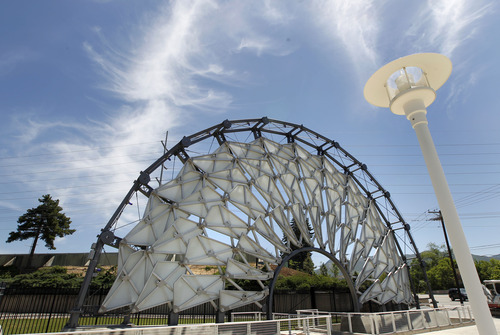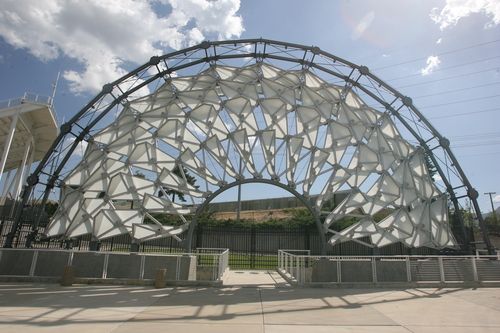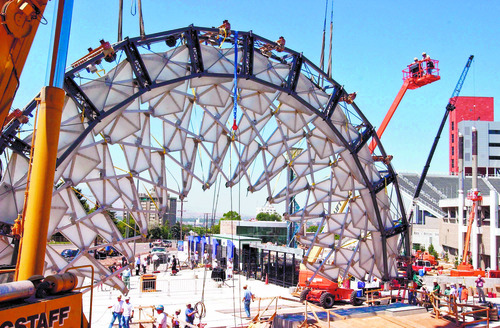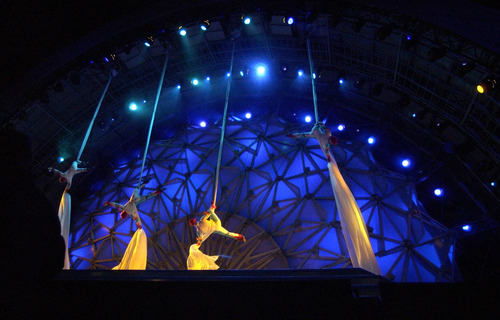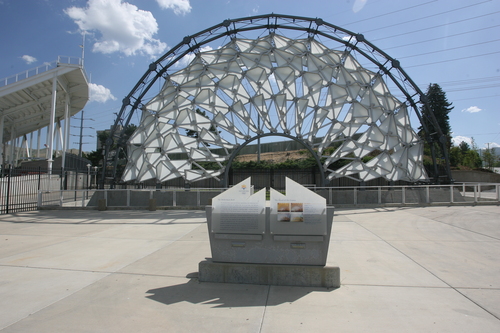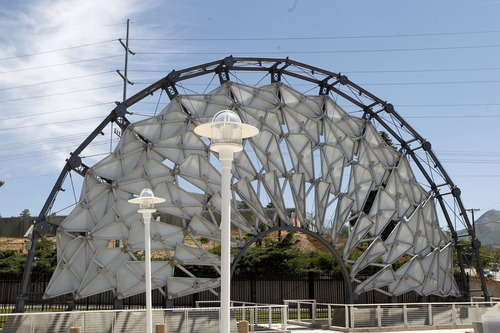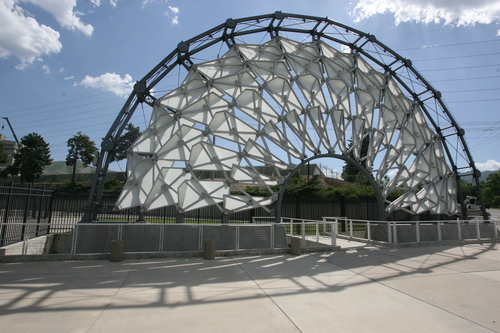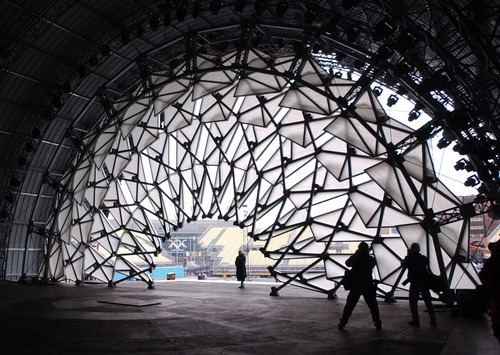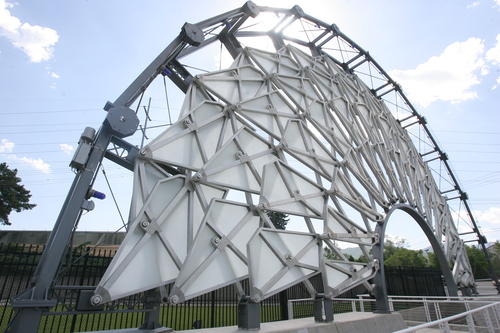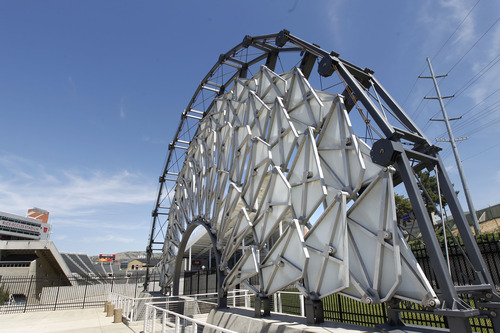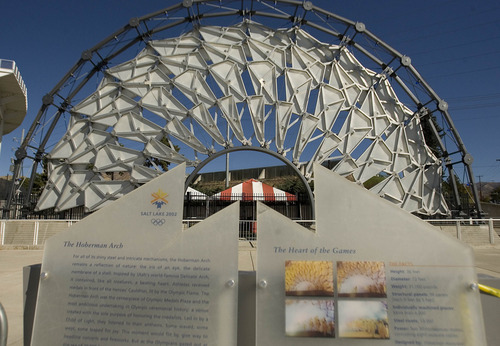This is an archived article that was published on sltrib.com in 2013, and information in the article may be outdated. It is provided only for personal research purposes and may not be reprinted.
The search is on to find a suitable new home for the Hoberman Arch.
An iconic symbol of the 2002 Winter Olympics, when it occupied the Medals Plaza stage and provided a dramatic centerpiece for introductions of the day's medal-winning athletes, the arch has stood for the past 11 years just outside the southeast end of Rice-Eccles Stadium at the University of Utah.
But with the U. now in the Pac-12, stadium expansion is a certainty somewhere down the road. Adding 10,000 seats with a new south end-zone bowl means the arch will have to go. So university officials have launched informal discussions about finding a new home for the mechanical arch — a kind of high-tech stage curtain — which last opened on Feb. 24, 2002.
"The arch is obviously part of our Olympic heritage," said Gordon Wilson, who is leading the search as U. assistant vice president of auxiliary services. "We're looking at what would be a good home for it. We want to do the right thing with this."
So Wilson reached out to Colin Hilton, president and CEO of the Utah Olympic Legacy Foundation, which oversees a number of legacies of the 2002 Games, most notably Utah Olympic Park outside of Park City and the Utah Olympic Oval in Kearns.
Hilton broached the subject with officials in Salt Lake City and Park City, along with members of his foundation's board, initiating discussions in a process that so far has no deadline.
"There's no announcement on the horizon," Wilson said. "We're just laying the groundwork for the future, looking ahead to do the right thing and keep the Olympic spirit alive."
But finding a new location for the arch could be difficult.
Its size — 36 feet high and 72 feet wide — limits the options. So do restrictions aimed at protecting the valuable Olympic brand. The U.S. Olympic Committee will not allow the arch to be placed near companies that compete with Olympic sponsors, such as restaurant rivals of McDonald's.
That became a problem in the year after the Olympics when the Salt Lake Organizing Committee conducted a lengthy search for a good location for the arch. Thoughts of putting it at Gallivan Plaza or Pioneer Park were rejected for different reasons. SLOC eventually donated it to the U., which made it an integral part of Olympic Cauldron Park, with a visitors center, fountain, placards highlighting each of the Games' 17 days and the caldron itself.
The process produced much bickering within Salt Lake City Hall, with then-Mayor Rocky Anderson and several City Council members blaming one another for losing downtown's chance to hold on to a major Olympic symbol.
Current Mayor Ralph Becker's administration is interested in taking another look at having the arch on display downtown, said his spokesman, Art Raymond.
"We would happily entertain that idea and would love to be part of the discussion as far as a new home for the arch," he said, emphasizing that no formal effort is underway. As the process advances, Raymond added, the city will need more information about the costs associated with maintaining the structure.
"We'd look at those things closely, regardless of our emotional attachment to the arch," he said. "That would have to be part of our big-picture consideration. But, certainly, we would be amenable to being a host for relocation."
When the Park City Council discussed the issue June 6, council members heard it could cost $200,000 to move the arch to their city, a hub for many of the Games' outdoor events. But the arch was not part of Park City's Olympic experience, a fact that troubled some council members.
"The council was split on whether we want to take this on," said Park City Mayor Dana Williams. "We need a little more information about the logistics. Where in the world are we going to put it? What in the world are we going to do with it?"
Park City officials will spend the next few weeks looking for answers that will determine the city's level of interest, Williams added.
For Hilton, as head keeper of the Olympic legacy, a site in Salt Lake City would be the best choice. "It did reside in downtown. If there's a good [potential] home there, that might have a leg up on the others. But it's the university's decision. They own it."
Wilson said the U. plans to incorporate the caldron into designs for an expanded stadium and to keep the fountain. Artifacts in the visitors center already have been transported to the museum at Utah Olympic Park.
Twitter: @sltribmikeg Hoberman Arch
Utah's desert arches inspired Chuck Hoberman's design.
Built by Scenic Technologies of New Windsor, N.Y., the arch was unveiled at the Medals Plaza in downtown Salt Lake City on Jan. 25, 2001.
The semicircular aluminum structure is 36 feet tall, 72 feet wide, weighs 31,000 pounds and has 4,000 parts.
During the 2002 Games, the arch's backlit panels opened nightly at the Medals Plaza (a 20-second process) to show the Olympic logo, a burning caldron and the gold, silver and bronze medalists in the day's events.



